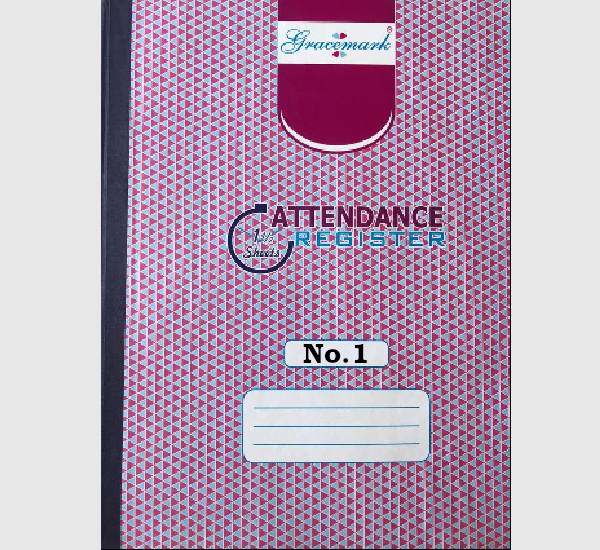Gracemark Plain Register No. 1
-
Super white pages.
-
Special canvas binding on the back and edges.
-
Thread sewing binding for long-lasting strength.
-
The register has a hardcover and is in A4 size.
-
These registers are safe for all age groups and environment-friendly.
- Description
- Size Guide
- Additional information
Description
- GSM: 58
- No. Of Pages: 64
- No. Of Register: 1
- Paper: Maplitho Paper
- Pack Of: 1 pcs plain register in a pack.
- Country Of Origin: India
- Manufactured By: Shri Naminath Paper Products, No. 56, Bhram Arya Samaj Mandir Complex, Gwynne Road, Aminabad, Lucknow-226003, Uttar Pradesh.
1. Introduction
Grace marks have long been a subject of interest in educational systems across the globe. A Grace Mark Plain Register is an essential tool educational institutions use to systematically record and allocate grace marks to students. These marks are usually awarded to students who narrowly miss passing an exam or to reward effort and improvement. This article delves deep into the structure, benefits, challenges, and future of the Grace Mark Plain Register, offering valuable insights for educators and policymakers alike.
2. History of Grace Marks
Origin of Grace Marks: The concept of grace marks originated as a way to offer students a second chance at passing exams. In the early 20th century, educational institutions began to experiment with awarding additional marks to students who showed genuine effort or encountered unforeseen challenges during examinations.
Evolution and Adoption in Different Educational Systems: Over time, the use of grace marks expanded beyond a few local systems and gained widespread recognition in national and international education policies. Different countries adapted the use of grace marks to suit their needs, and today, it remains a common practice in many examination systems worldwide.
3. Structure of a Grace Mark Plain Register
Components of the Register: A typical Grace Mark Plain Register contains fields for student names, subject details, original marks obtained, and the grace marks awarded. This record is crucial for maintaining transparency and ensuring students are fairly evaluated.
How the Register is Used by Educational Institutions: Educational institutions use the register to systematically track students’ performance and allocate grace marks according to predefined criteria. Administrators and teachers ensure that the allocation follows institutional policies and is in line with educational regulations.
4. Benefits of Using a Grace Mark Plain Register
Standardization and Transparency: One of the key benefits of using a Grace Mark Plain Register is its role in standardizing the process of awarding grace marks. This ensures transparency and fairness, preventing any bias in grading.
Helping Students Improve Performance: Grace marks are often seen as a safety net for students who show potential but fail to meet the passing mark by a narrow margin. These additional marks can boost a student’s confidence and motivation to perform better in the future.
5. How Grace Marks are Applied
Criteria for Awarding Grace Marks: Grace marks are typically awarded to students who come close to passing but miss the cut-off by a small margin. The specific criteria can vary by institution, but generally, they are applied when students demonstrate consistent effort or encounter extenuating circumstances.
Differences Between Educational Systems: While the principle of grace marks is similar across many educational systems, the exact application can differ. For example, some countries may limit the amount of grace marks that can be awarded, while others might have more flexible rules.
6. Technology Integration
Digital Solutions for Managing Grace Mark Registers: In the age of technology, educational institutions are moving toward digital systems for managing Grace Mark registers. These solutions not only enhance efficiency but also reduce the likelihood of errors in the allocation process.
The Role of Artificial Intelligence and Data Analytics: Artificial intelligence (AI) and data analytics are emerging as powerful tools in the education sector, allowing institutions to analyze student performance data and make informed decisions about grace mark allocations.
7. Case Studies
Countries Implementing Grace Marks Effectively: India, for instance, has a well-established system for awarding grace marks in various national and state-level examinations. Other countries, such as Pakistan and Sri Lanka, have also adopted similar practices.
Success Stories in Education Reform: In many cases, grace marks have been credited with helping students from disadvantaged backgrounds succeed academically, thereby reducing dropout rates and improving access to higher education.
8. Challenges in Implementing Grace Mark Registers
Issues with Fairness and Subjectivity: One of the main challenges in using grace marks is the issue of fairness. Some argue that grace marks can create an uneven playing field by benefiting only certain students, leading to debates on subjectivity and bias.
Difficulties in Aligning Different Curriculums: Another challenge arises when attempting to implement grace marks in international curricula, as grading systems and academic standards can vary widely.
9. Future of Grace Mark Registers
Emerging Trends in Assessment and Education: The future of grace marks lies in the broader movement toward more personalized and competency-based learning. Emerging trends in assessment may lead to reforms that alter the way grace marks are awarded.
Predictions for the Future of Grace Marks in Education: As education evolves, we may see a shift toward more sophisticated and data-driven methods of awarding grace marks, potentially enhancing both fairness and effectiveness.
10. Legal and Ethical Considerations
Legal Frameworks Governing Grace Marks: In many countries, grace marks are governed by specific legal frameworks that ensure transparency and prevent misuse. These laws provide guidelines on when and how grace marks can be applied.
Ethical Debates Around the Use of Grace Marks: While grace marks are intended to help students, they also raise ethical questions. Some educators argue that they dilute academic standards, while others believe they are necessary for creating a fairer system.
Frequently Asked Questions ?
A Grace Mark Plain Register is a formal document educational institutions use to record grace marks awarded to students. Grace marks are additional points given to students who narrowly miss passing an exam, often due to special circumstances. The register helps track and document these adjustments in a transparent and standardized way.
Eligibility for grace marks varies by institution and educational system, but typically, students who are very close to the passing mark may be eligible. Some systems also provide grace marks for students who demonstrate consistent effort or face unforeseen challenges during exams, such as illness or family emergencies.
Grace marks are usually calculated based on a predefined criterion set by the institution or examination board. The number of marks awarded depends on how close the student is to passing. For example, if the passing score is 40, a student scoring 38 might receive 2 grace marks to pass. Institutions may have limits on how many grace marks can be given.
Yes, grace marks can affect a student’s final grade or GPA. If grace marks push a student from failing to passing, their overall academic standing improves. However, the exact impact depends on the institution’s policies on incorporating grace marks into final results or GPA calculations.
This depends on the rules of the specific educational system. In some institutions, grace marks can be applied across all subjects, while in others, they may be restricted to specific courses or types of exams. Generally, subjects with practical assessments may have stricter rules regarding grace marks.
Grace marks are less commonly awarded in competitive exams, as these are typically designed to rank candidates based on performance. However, some competitive exams may offer grace marks in specific cases, such as errors in the exam paper or ambiguous questions that affect the overall scoring.

| size | chest(in.) | waist(in.) | hips(in.) |
|---|---|---|---|
| XS | 34-36 | 27-29 | 34.5-36.5 |
| S | 36-38 | 29-31 | 36.5-38.5 |
| M | 38-40 | 31-33 | 38.5-40.5 |
| L | 40-42 | 33-36 | 40.5-43.5 |
| XL | 42-45 | 36-40 | 43.5-47.5 |
| XXL | 45-48 | 40-44 | 47.5-51.5 |
Additional information
| Weight | 0.150 kg |
|---|---|
| Dimensions | 33 × 20.6 × 1.4 cm |









